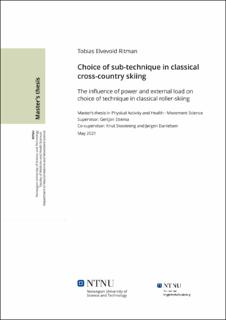| dc.description.abstract | Formål: I klassisk stil i langrenn er det tre hovedteknikker som er diagonal gang (DG), staking (ST) og staking med fraspark (STF). I klassisk stil, brukes ulike delteknikker mest avhengig av terreng. Hensikten med denne studien er å undersøke om ytre belastning vil ha innvirkning på den spontane endringen i teknikken i klassisk langrenn. Den ytre belastingen ble regulert ved å endre en motstandskraft.
Metoder: 6 menn (24,1± 2,1, kroppsvekt 77,6± 4,4 og høyde 180,5 ± 1,6 ± 4,4 og høyde 180,5 ± 1,57) og 8 kvinner (21,7± 1,7, kroppsvekt 62,6 ±7,1 og høyde 169,7 ± 3,6). Forsøkspersonene utførte fire forskjellige tester. Hver test varte i maksimalt 6 min og 20 sek. Hver kondisjon besto av en trinnvis innledende og omvendt rekkefølge av ekstern belastning. Ved starten av hver test, startvekt på ekstern belastning på 500g. Fra denne startvekten ble det lagt til 500g hvert 20 sekund til maksimalt 5kg på 3 minutt.
Resultat: Det var en overlapping i power av de forskjellige underteknikkene som viser at minimumseffekten av bruk i DG var betydelig lavere enn maksimal STF (p<.001), samme for minimum STF og maksimal ST. Det var en statistisk signifikant effekt mellom stigning og valg av teknikk (p<.001), men ikke signifikant mellom hastighet og valg av teknikk (p=.521). Det var en signifikant effekt av hysterese i overgangen mellom opp- og nedprotokoll i teknikkskift mellom ST of STF i kondisjonene 10 km/t og 8% stigning (p=.012) og 12 km/t og 8% stigning (p=.004). Den samme effekten ble funnet for STF til DG på 10 km/t og 5% stigning (p=.024).
Konklusjon: Hovedfunnene i denne studien er at belastning spiller en rolle i teknikkbruk, men ser ikke ut til å fungere som en kontroll parameter. I noen forhold ser den ytre belastingen ut til å fungere som en kontrollparameter, i det minste for overgangen mellom STF til ST. Hastighet påvirket ikke motstandskraften; mengden ekstern belastning var den samme som utøverne byttet fra STF til ST. Det samlede utfallet indikerer at stigning påvirker valg av teknikk i en større grad enn hastighet. | |
| dc.description.abstract | Purpose: In cross-country skiing the classical style there are three main techniques are diagonal stride (DS), double poling (DP) and double poling with kick (DK). In classical style, in training and competition, different sub-techniques are used mostly depending on terrain. The purpose of this study is to investigate if external workload will have impact on the spontaneous change in technique in classical cross-country skiing. Workload was regulated by changing a resistance force.
Methods: Six males (age 24.1 ± 2.1, body weight 77.6 ± 4.4 and height 180.5 ± 1.7) and eight females (age 21.7 ± 1.7, body weight 62.6 ±7.1 and height 169.7 ± 3.6). The athletes performed four different tests. Each test lasted maximally 6 min and 20 sec. Each condition consisted with an incremental initial and reversed order of external load. With using external load, speed, and incline we were able to isolate one of the parameters. At the start of each test, an offset external load of 500g. From this onset load, 500g was added every 20th second, up to a maximal of 5 kg at 3 min.
Results: There was an overlap in power of the different sub-techniques that show that the minimum power of use in DS was significantly lower than maximum DK, and maximum DP and minimum (p<.001). There was a statistically significant interaction effect between incline and choice of technique (p<.001), but not significant between speed and choice of technique (p=.521). There was a significant effect of hysteresis in transition between up and down protocol in technique shift DP to DK in condition 10 km/h and 8% incline (p=.012) and at 12 km/h and 8% incline (p=.004), and for condition for DK to DS, 10 km/h and 5% incline (p=.025).
Conclusion: Power plays a role in technique use but does not seem to act as a control parameter. In some conditions, the resistance force seems to act as a control parameter, at least for the DK-DP transition. Speed did not affect the force of transition; the amount of external load was the same at which the athletes switched from DK to DP. The overall outcome indicates that incline is a stronger determinant for choice of technique than speed. | |
